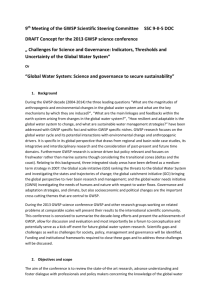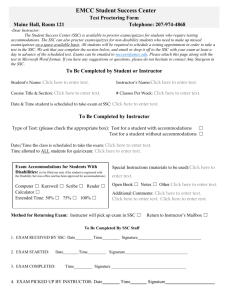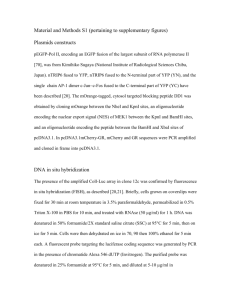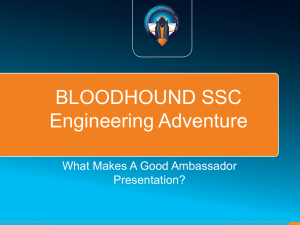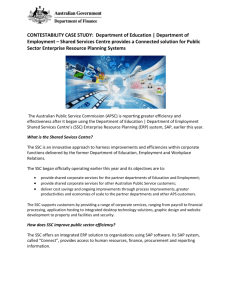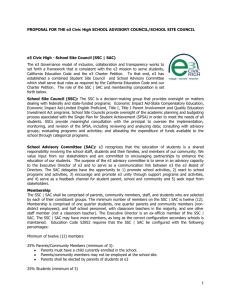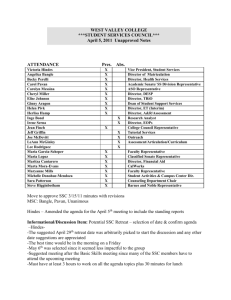doc - Global Water System Project
advertisement
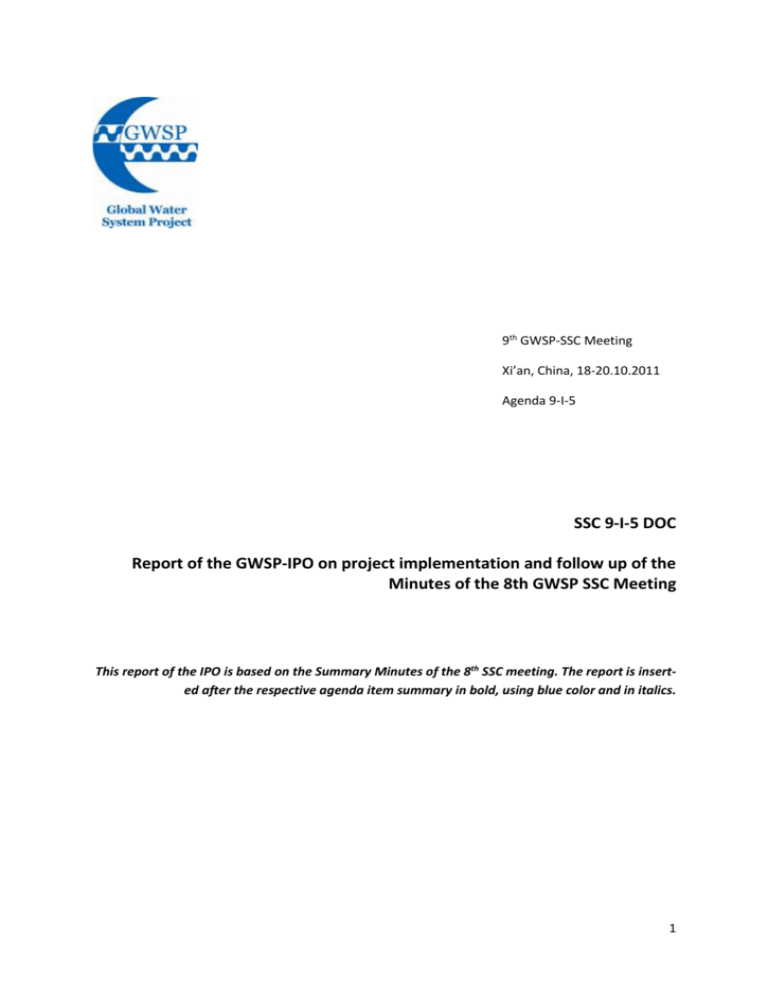
9th GWSP-SSC Meeting Xi’an, China, 18-20.10.2011 Agenda 9-I-5 SSC 9-I-5 DOC Report of the GWSP-IPO on project implementation and follow up of the Minutes of the 8th GWSP SSC Meeting This report of the IPO is based on the Summary Minutes of the 8th SSC meeting. The report is inserted after the respective agenda item summary in bold, using blue color and in italics. 1 Index List of Abbreviations ................................................................................................................................ 3 1 Welcome, tour de table, changes in the SSC (8-I-1) ................................................................ 6 2 Discussion and approval of the minutes of the 7th SSC meeting (8-I-2) ................................. 6 3 Review of the draft and final establishment of the agenda for the 8th session of the SSC meeting (8-I-3) ......................................................................................................................... 6 4 Reports of associated projects and discussion (8-I-4) ............................................................. 6 5 Reports of the Co-Chairs, the IPO and the GWSP initiatives (GSI, GCI, GWNI, GWG) (8-I-5, 8II-2, 8-II-3, 8-III-2, 8-III-3, 8-III-4) .............................................................................................. 7 6 Reports of GWSP regional nodes and activities (8-II-4) ......................................................... 13 7 Reports of GEC programmes, ESSP and invited guests (8-II-5 – 8-II-15) ............................... 14 8 Reports of SSC members (8-III-1) ........................................................................................... 15 9 Future developments of IPO and SSC (8-III-5, 8-III-6) ............................................................ 15 10 Vision / Implementation Plan for the GWSP Synthesis Phase (8-II-16, 8-III-4, 8-III-7) .......... 16 11 Matrix of Vision / Implementation Plan for GWSP Synthesis Phase ..................................... 18 12 Closing, venue of the 9th meeting of SSC (8-III-8) .................................................................. 20 2 List of Abbreviations AIS Activity Information System BioFresh Biodiversity of Freshwater Ecosystems (EU funded project) BfG Bundesanstalt für Gewässerkunde, Federal Institute of Hydrolgy BMBF Bundesministerium für Bildung und Forschung; German Federal Ministry of Education and Research CAS Chinese Academy of Sciences CC Climate Change CCNY-CUNY City College New York of the City University of New York CNC Chinese National Committee DFG Deutsche Forschungsgemeinschaft; German Research Foundation DIVERSITAS International Programme on Biodiversity Science DLR Deutsche Luft- und Raumfahrt (Aerospace Research Institute of Germany) DRI Drought Research Initiative DWA Digital Water Atlas (of GWSP) ED Executive Director EO Executive Officer ESF European Science Foundation ESG Earth System Governance Project (of IHDP) ESSP Earth System Science Partnership GCI Global Catchment Initiative (GWSP) GEC Global Environmental Change GECAFS Global Environmental Change and Food Systems GECHH Global Environmental Change and Human Health (Joint ESSP Project in partnership with WHO and UNU-INWEH) GEO Group on Earth Observations GEO Global Environmental Outlook (of UNEP) GEO BON GEO Biodiversity Observation Network GEWEX Global Energy and Water Cycle Experiment (Core Project of WCRP) GLOWA Volta Global Change and the Hydrological Cycle in the Volta Basin (Africa) Project GLOWA-IMPETUS ditto for Wadi Draa and River Ouéme (Africa) Project GRanD Global Reservoir and Dam (database) GRDC Global Runoff Data Center GSI Global Scale Initiative (GWSP) GTN-H The Global Terrestrial Network – Hydrology GWG Global Water Governance (GWSP) 3 GWNI Global Water Needs Initiative (GWSP) GWSP Global Water System Project HWRP Hydrology and Water Resources Programme (of WMO) ICSU International Council for Science IGB Leibniz-Institut für Gewässerökologie und Binnenfischerei; Leibniz-Institute of Freshwater Ecology and Inland Fisheries IGBP International Geosphere-Biosphere Programme IGWCO CoP Integrated Global Water Cycle Community of Practice Coordination IHDP International Human Dimensions Programme IPBES Intergovernmental Platform on Biodiversity and Ecosystem Services IPO International Project Office (of GWSP) IRDR Integrated Research on Disaster Risk (Project of ICSU) ISDR International Strategy for Disaster Reduction (of UN) IWAS International Water Research Alliance Saxony IWRA International water Resources Association IWRM Integrated Water Resources Management KOWA DFG Commission on Water Research MDG Millennium Development Goals NL Newsletter NSF National Science Foundation (of the USA) PIK Potsdam Insitut für Klimafolgenforschung, Potsdam Institute for Climate Impact Research PSI Pilot Study on Indicators RHP Regional Hydrology Projects (of GEWEX) SO Science Officer SSC Scientific Steering Committee TUD Technische Universität Dresden; Dresden University of Technology Twin2Go Coordinating twinning partnerships towards more adaptive governance in river basins UFZ Helmholtz Centre for Environmental Research UNDP United Nations Development Programme UNEP United Nations Environmental Programme UNESCO United Nations Educational Scientific and Cultural Organisation UNESCO-IHE United Nations Educational Scientific and Cultural Organisation – Institute for Water Education 4 UNESCO-IHP United Nations Educational Scientific and Cultural Organisation - International Hydrological Programme UNFCCC United Nations Framework Convention on Climate Change UNU United Nations University UNU-EHS United Nations University Institute for Environment and Human Security UNU-IHDP United Nations University - International Human Dimensions Programme on Global Environmental Change (the Secretariat of IHDP) UNU-INWEH United Nations University - Institute for Water, Environment and Health UNU-FLORES United Nations University Institute for Integrated Management of Material Fluxes and of Resources UN-Water United Nations inter-agency coordination mechanism of fresh water programmes UNW-DPC UN-Water Decade Programme on Capacity Development WATCH Integrated Project Water and Global Change (EU) WaterMIP WATCH-GWSP Water Model Intercomparison Project WCRP World Climate Research Programme WMO World Meteorological Organization WWAP World Water Assessment Programme (UN-Water) WWAP EG IMD WWAP Expert Group on Indicators, Monitoring and Databases WWDR World Water Development Report ZEF Zentrum für Entwicklungsforschung; Center for Development Research of the University of Bonn (host of the GWSP-IPO) 5 Summary Minutes This minute summarizes the proceedings of the 8th meeting of the Scientific Steering Committee of GWSP. The summary report contains 11 sections referring to different items of the original agenda. As there were more agenda points than sections in these minutes several agenda points contributing to the same issues are reported together. In the section titles the respective agenda points are listed. 8 stands for the 8th meeting of the SSC, the Roman number indicates the day when the agenda point was originally scheduled and the third number is the serial number for the respective agenda on the given day. 1 Welcome, tour de table, changes in the SSC (8-I-1) The GWSP welcomed Prof. Sharad Kumar Jain as new SSC member. SSC member Prof. Dr. Claudia Pahl-Wostl was welcomed as new GWSP-SSC-Co-chair as of 1 December 2010, replacing Prof. Dr. Joseph Alcamo who resigned from the SSC. In tribute to his work many warm hearted and sincere thanks were expressed by the SSC and the GWSP community. 2 Discussion and approval of the minutes of the 7th SSC meeting (8-I-2) Approval of the minutes of the 7th SSC meeting held in 2009, in Stellenbosch, South Africa: minutes approved unanimously, no changes needed. Review of the draft and final establishment of the agenda for the 8th session of the SSC meeting (8-I-3) The latest version of the draft agenda, handed out to the participants at the beginning of the meeting, remained undisputed by the meeting participants and thus unchanged. However, during the following days of the meeting changes were effected due to travel changes made by participants and the internet/skype participation by Charles Vörösmarty, where time slots and the agenda had to be adopted to enable cross-continental communication. Agenda point 8-III-7 was barely touched upon as the brainstorming discussion focused on the synthesis phase of GWSP. (See also Section 10) 3 4 Reports of associated projects and discussion (8-I-4) Three endorsed (associated) projects were represented and reported about their respective activities Model Intercomparison Project “Water-MIP” (Frank Voss, University of Kassel); Twin2Go Project (Claudia Pahl-Wostl, University of Osnabrück); Consistent Assessment of Global Green, Blue and Virtual Water Flows in Food Production (Dieter Gerten, PIK Potsdam). During the reporting period collaboration was very intensive with the Twin2Go project (joint seminar and distribution of Twin2Go material from the GWSP exposition stand during the World Water Week in Stockholm in August 2011. The collaboration was also quite active with the Project Consistent Assessment of Global Green, Blue and Virtual water Flows in Food Production. On behalf of GWSP a senior researcher of this project gave a presentation in Stockholm at a joint GWSP-Botin Foundation-UNEP-UNESCO session on water and food security. Collaboration was less active with the Water-MIP project, irrespective that Bonn was foreseen as the next meeting location. Staff movement from one of the key partners contributed to this reduction. Collaboration started with the Water Ethics Network considering the potential that this network may apply for endorsed project status. 6 5 Reports of the Co-Chairs, the IPO and the GWSP initiatives (GSI, GCI, GWNI, GWG) (8-I-5, 8-II-2, 8-II-3, 8-III-2, 8-III-3, 8-III-4) (8-I-5, 8-II-2) Short summary of GWSP activities so far: initiative of a comprehensive capacity building, strategic meeting and awareness raising concept “Bonn a Global Water City” was continued and included: monthly joint Water Lectures (ZEF, UNU-EHS, UNW-DPC and GWSP); a ZEF-GWSP proposal for annual summer academies for young water scientists has been formulated and submitted to BMBF (response is pending); two meetings on the “Bonn a global water city” initiative were held with the Bonn Water Community and received positively; EO IPO was consulted by the German Government on the forthcoming intergovernmental conference “Water, Energy and Food security Nexus Solutions for the Green Economy”, 16-18 November 2011 in Bonn. The series of water lectures in Bonn continues. This year the University of Bonn proposed to join the group of organizers (GWSP, UNU-EHS, UNW-DPC and ZEF). The formal establishment of “Bonn a global water city” did not happen, but several coordinated activities are ongoing with various partners. Lecture series with the Asia Center of the university of Bonn, application and lecture series with the proposal of a graduate college on risk management “Extreme Water”. The IPO was involved in several capacity building activities, including the DVD based series on integrated water resources management lectures. The EO gave one lecture on IWRM and vulnerability. BMBF did not respond to the submitted request to fund the envisaged summer academies. Hence this issue is still pending. (8-I-5) Concerning the new initiatives launched at the 7th SSC meeting in Stellenbosch nothing happened in the 1st research area “The water climate change mitigation link”. Still no progress can be reported on this initiative. On the 2nd research area “Water and migration” an IPO research assistant is working (research ideas are presented later in this meeting). The proposal was elaborated and submitted to the IPSWaT scholarship programme of BMBF. The submission in spring 2011 was successful. However the candidate has accepted in the meantime an offer to join another PhD project (programme). As the IPSWaT scholarship was person-bound the opportunity to start this initiative was lost. In the framework of the 3rd research area “Water and health” EO IPO has attended the kick off symposium of GECHH and the subsequent GECHH-SSC meeting. Agreement was reached to cooperate in the regional water-health nexus mapping with the potential to add maps to the Digital Water Atlas. GWSP was invited to contribute with an article to the special issue of COSUST on water and health. This paper was submitted in spring 2011 (co-authored by the EO and two senior researchers from ZEF). Recently the paper has been resubmitted after having received the review comments. Within the 4th research area “National water stress/susceptibility report cards” a potential cooperation area between GEWEX and GWSP was discussed at the Pan GEWEX meeting in August 2010. GEWEX is interested in collaboration, especially in the area of how water and health indicators can be mapped. The IPO was not involved in activities which might contribute to this initiative. 7 There were comments about the visibility of GWSP: If GWSP has contributed (financially) to the project, then GWSP has to be mentioned in publications; Irrespective of the substantial participation of several scientists active also in GWSP, if GWSP-relevant work is done, it should not be hidden. New flyer, new scroll ups, a computer-based info show, theRio+20 policy brief No.1 of the GEC Programmes and ICSU bearing the GWSP logo and other activities like an exposition stand (together with the Botin Foundation) in Stockholm manifest the efforts in this direction. GWSP is sponsoring the IWRM conference in Dresden and the IWRA symposium in Xi’an, both in October 2011. A proposal from the SSC is to strengthen regional nodes (e.g. Asia needs more attention in terms of specific (not general) research programs planning). Due to the resignation of Prof. Marengo as member of the GWSP SSC the Latin American activities became less intensive. Regional nodes in Asia and Africa are more active: see the workshop in Xi’an following the 9th SSC meeting. However the issue of formal (or informal) regional nodes and geographical distribution of active GWSP researchers should be discussed. GWSP is rather a network to implement ideas than a single-focus project. Activities in the Phase I of GWSP included among others, Digital Water Atlas, Lexicon (joint terminology), World water balance, Global Water indicators, Global Water Governance Program, teaching activities. In Phase II, integrative study areas evolved: (1) Global Scale Initiative (GSI) (key person: Charles Vörösmarty), (2) Global Catchment Initiative (GCI) (key person: Joseph Alcamo till November 2010). (3) Global Water Needs Initiative (GWNI). Needs of Humans and Nature (key person: Claudia Pahl-Wostl). The issues are now more strongly linked to a discourse than to the framing questions. GWSP activities overall include: interdisciplinary science and policy advice, study human impact on GWS, global network of researchers, short-term initiatives and workshops, long-term projects, expert groups, conferences. (8-II-3) GCI: 2010 could be characterized as the year of GCI. 2nd GCI workshop on Global aspects of water research and management in large river basins (17-19 February, 2010): downscaling from global to large basin scale was held in Bonn, Germany. 10 GCI research questions were answered for 14 basins during the workshop. As a background paper, participant responses and perceptions after the workshop were summarized by Roland Schulze and published by the IPO. After the successful GCI conference in December 2010 the editorial team met in January 2011 to plan for the follow up book. It was agreed that the book would have an educational goal and the target audience would be mainly graduate students. UNESCO-IHE joined the publication effort and delegated Prof. Jan Leentvaar as co-editor. The potential authors were notified and manuscripts/revisions solicited. Most of the responses were received by summer 2011. Early August a one week long editorial meeting took place in Olbendorf, Austria. The submissions have been reviewed and sent back to the authors for revisions. It was agreed that the book should come out as an electronic (web-based) publication with a CD based free distribution version for the 6th World Water Forum in Marseille 2012 March. The publication contains only those papers which were presented at the conference. The book is scheduled to be ready by the end of 2011. The final editorial meeting is scheduled on 31 October 2011 in Bonn. The proceedings and reporting on the event was done in spring 2011 and can be found on the GWSP website at: http://www.gwsp.org/fileadmin/GCI_conference/Products/GWSPGCI%20conference%202010%20Proceedings.pdf 8 In May 2011 a meeting took place in Bonn to evaluate the first phase of the GCI initiative. Following this meeting the questionnaires used in the 20092010 phase were revised. In order to improve the focus the water-energyfood security nexus will be aimed to be explored through two sets of questionnaires to be distributed among experts and scientists involved in management and/or research in large catchments. The questionnaires started to be distributed in Stockholm World Water Week. An evaluating workshop is planned for April 2012 in Winnipeg, Canada, together with the International Institute on Sustainable Development, which is interested to enter into a longer partnership with GWSP. (8-II-3) GCI conference “The global dimensions of change in river basins: Threats, Linkages and Adaptation” was held on 6-8 December 2010 in Bonn, Germany, counting more than 120 participants. (8-II-3) GSI: Article vol.467 in “Nature” (collaborative work with DIVERSITAS) was an important project outcome. IPOs of the three programmes (ESSP, DIVERSITAS and GWSP) hired a media consultant. The media campaign was very satisfactory with over 240 media appearances. Ever since the “Nature Article” is becoming an essential GWSP (and DIVERSITAS and ESSP) trademark. The work is frequently cited and results feature prominently in the forthcoming 5th issue of UNEP-GEO Water Chapter. (8-II-3) GWNI incl. Global Water Governance: A Workshop on Global Water Governance and the UN System was conducted in October 2010 in Bonn. Another workshop was held at the GCI conference (6-8 Dec.2010). The raised questions were: what are major (present and emerging) challenges for global water governance? Can they deal with the current situation? 2011 is a GWSP year in the sign of water governance. The co-sponsored conference in Obergurgl Austria was instrumental to create what may be called the science community on global water governance. The endorsed project Twin2Go held a very successful closing conference (half day long) in Stockholm during the World Water Week in August 2011. In November 2011 a workshop will take place on environmental flow requirements and assessment including the governance dimension. (8-II-3) Digital Water Atlas: At the moment there are 68 global maps (including descriptions & corresponding datasets for download) in the DWA; 141 web links to other info/data sources; more than 120,000 map visits; over 1600 registered users from about 45 countries. Datasets have been downloaded more than 4100 times. There are two datasets on biodiversity in the DWA: Freshwater Ecoregions and a Global Wetlands Database. The “migration” of the DWA to a safe operating environment is approaching completion. Discussions with BfG (UNESCO IHP and WMO HWRP Secretariat) on hosting the DWA after the closure of the GWSP-IPO are developing well as the partner has secured the necessary financial support. 9 (8-II-3) Water and migration: Proposed research on “Is there a ”water footprint“ of (environmental) migration and can this be explored by linking water indicators with migratory fluxes?” is planned on global and local scales. See chapter 5 on page 7 . (8-I-5) GWSP-IPO Newsletter №9 was published in August 2010. The Newsletter of GWSP-IPO provides good insights into what is happening in the project. Comments from SSC members on what can be improved (quality and style) were accepted. It was suggested to publish newsletters twice a year and to decrease number of pages to 20-22. A correspondingly shorter Newsletter No. 10 was finalized in July 2011 and distribution started internationally in the Stockholm World Water Week. Newsletter No. 11 is planned for February 2012 (to start international distribution in Marseille and London at the Planet under Pressure GECConference. Issue No 11 is likely to be the last GWSP newsletter unless the IPO can be sustained beyond spring 2012. (8-I-5) GWSP-IPO Newsletter №7 was highly requested. (8-III-4) Memorandum of Understanding between GWSP and ESGP was accepted. The MoU was signed in spring 2011. Planned activities of the GWSP include: (8-III-2) Next SSC meeting will be held in October 2011 in Xi’an, China, prior to the “International Symposium on Impacts of Climate Change on Water Resources in Arid and Semi-arid Regions”. This symposium is co-sponsored by GWSP. Done. (8-III-4) There will be no proceedings published after the GCI conference in December 2010, but a synthesis book. The book will have an educational value (reviewed and published together with UNESCO-IHP). Timeline: should be ready towards the end of 2011 – early 2012. See under GCI report chapter 5 on page 7. (8-II-3) GWSP shall aim for side events in 2011-2012: (8-II-3) There will be an ESF conference “Water Governance: Meeting the Challenges of Global Change” in June 2011. Presented themes are: 1. Global governance of water – current developments and future prospects. 2. Water governance addressing global change and climate change. See under GWNI/GWG report chapter 5 on page 9. (8-II-3) There is an opportunity for GWSP to present GWG at the international community during the World Water Forum in Marseille. The focus of discussions might be: „World Water solutions – good governance is an issue“. From the political point of view, key persons of policy should be invited to the workshop. GWSP, together with the Think Tank of the Gulbenkian Foundation, WWAP, UNESCO-IHE and the Water and Climate Project co-organizes the session on long term vision, monitoring and indicators at the 6th World Water Forum in 10 Marseille 12-17 March 2012. The session organization started de facto in Stockholm in August 2011. (8-II-3) In March 2012 in London, UK, there will be the GEC Conference “Planet under Pressure”. It is a good opportunity for GWSP to contribute to the conference, which is both, interdisciplinary and “inter-scale - from global to local”. There will be a 90 minute long session with a great number of co-sponsoring institutions and partners. This merged session is the consequence of the enormous interest in the Planet under Pressure Conference. While there are five conveners, GWSP is the corresponding organization and the EO is the contact person. Partners are the Research Institute for Humanity and Nature, Japan, Stockholm International Water Institute, UNESCO-IHP, Organization of American States, International Association of Hydrogeologists, International Water Resources Association, IWRA and CAS., as well as GEWEX and ESG, the original partners of the GWSP submission. The session “Integrated assessment, governance and management of water in a changing world at global, regional and transboundary levels” will have 5 speakers addressing these themes through the lens of the five grand challenges identified in the ICSU Visioning process. The two GWSP co-chairs are speakers; Prof Xia is one of the conveners. At present the submitted papers (only posters can be accepted) are being reviewed. With 80 submissions this session is one of the most popular ones. The conference received altogether about 4000 abstracts. (8-III-4) Stronger links to UN programs should be established, e.g. to become an official UN-Water partner. The GWSP-IPO EO would write an application. Due to the fact that GWSP as a project has no legal status ZEF applied on behalf of GWSP. The application was submitted in June 2011. However due to its crowded agenda UN-Water was unable totake the decision at its Stockholm meeting in August 2011. The decision whether the partnership status will be granted is expected at the spring session of UN-Water in 2012. (8-II-3) In the area of outreach, awareness raising, education: Water Lectures and summer academy are part of the IPO-initiative “Bonn a Global Water City”; See in chapter 5 on page 7. Next year the proposed Water Summer Academy is planned to be linked with the Stockholm World Water Week. See in chapter 5 on page 7. Due to lack of response (and funding) the event could not be organized. (8-II-3) Strategic Activities include: Collaboration with GEWEX, GECHH, ESG etc.. See in chapter 5 on page 7. Discussing GWSP synthesis and future activities; It is a substantial part of the agenda of the present 9th SSC meeting. 11 Trying to develop initiative projects and regional “Nodes“ rather than formal GWSP offices. See in chapter 5 on page 8. (8-III-4) GWSP Water Conference 2011 is postponed until the final synergy is delivered. Instead it was decided to have a conference in 2013, when it will also be possible to include results of a great number of conferences in 2011-2012, organized by others (including the “Planet under Pressure” conference in London, 2012). However, the 2013 conference should not be postponed for too long, since the future of IPO beyond spring 2012 is unknown. One proposal from the audience suggested to identify a core of keynote speakers to be invited in 2013 already early 2011. Then the book production and the conference planning could go hand in hand as an integrative effort. Another proposal is to make it a package that includes early contributions of steering committee and keynote speakers and have a community based communication assisted by the facilitator. The preparation of the “closing conference” of GWSP in 2013 is one of the most important agenda items of this 9th SSC meeting. (8-II-3) Twin2Go has a database on governance. It was proposed to set up a Global Governance Database. In future this governance database can be linked to databases on the state of the environment and it would be possible to find relevant correlations. (8-II-3) Projects like GWNI can attract more attention from people who want to have advice on water issues. The potential for that is in the ecosystem service approach, and how it links to conflicts and governance structures. (8-II-3) One proposal from the SSC was to have a workshop in order to restart discussing the issue of inventory of flows. What is “environmental flow”, what kinds of services are taken into consideration? Most important issue is how to debate about such questions at governance level. A GWNI workshop is being prepared along these recommendations and will take place in November 2011 in Bonn. (8-II-3) Proposed improvements for the DWA: make the Atlas a central entry point for GWSP, increase people involved and ensure provision of service. In particular, it is necessary to revise and discuss the conceptual framework of the Atlas, provide updated versions of existing maps and take up new maps for future scenarios, include all available maps and all maps that are on the ‘wish list’ to the conceptual framework. Unrelated data should not be added to the DWA. A small brochure about the Digital Water Atlas should be prepared. This brochure should have: a story to tell, what it is showing, how to interpret it. An interesting potential could be to bring together databases of GWSP and GTN-H. Also, there could be a potential link to GEO. GWSP-IPO participated in the workshop meeting of GEO EGIDA in May 2011 in Bonn but the other recommendations could not be followed up. (8-III-4) Make clearly visible on the GWSP website how the proposed project can be endorsed. Place terms of reference for endorsed projects. Done. 12 (8-III-4) How to label GWSP contributions: There is very little direct funding, GWSP is not yet visible enough. EO suggests using GWSP logo more systematically. Some progress: The donor insists that GWSP proves its ability to raise co-financing for joint events with partners or/and receive external funding for its work. Future activities of associated programs and initiatives with GWSP: (8-II-3) GSI: GSI can emphasize social and policy issues and link them with physical information on the hydrological cycle, represented by the GTN-H community. Datasets should be socially relevant. Indicators can be used to synthesize social and hydrological data. The DWA should be used to create a partnership towards this end. The corresponding meeting was scheduled for March 2011 in Tokyo. However it was seriously affected by the earthquake and tsunami. (8-II-3) GWNI: Policy workshops in different regions of the world are needed. Implement the database on the web as nucleus for a global database on water governance systems and networks of scholars and practitioners. Include further basins in the current database. Develop set of in-depth analyses focusing on key findings of the results from the exploratory analyses. See in chapter 5 on page 9. (8-III-3) Digital Water Atlas (DWA): Link to GEWEX atlas and datasets. Prepare 8 pages ready to be printed at GWSP website in March 2011. Produce a small brochure about the DWA. It was proposed to include products of the DWA atlas in the WWAP report. WWAP had also massive delays due to its retarded funding. Other recommendations could not be followed up. 6 Reports of GWSP regional nodes and activities (8-II-4) Planned GWSP Regional Activities (8-II-4) Africa: The SSC should consider whether a regional node would be feasible and preferable. SSC comment and proposal was that GWSP has potential to provide input to Southern African governance research, not only from global level but also from regional and national levels. Governance is needed on regional and local rural level. The gaps in between should be filled. GWSP principles should be fulfilled within such a project as following: the GWSP Capacity Building aspect should be covered, also feeding capacities back into the continent would mean at least to have a continental effect if not global. There is a need to select an African member to join the SSC. There was agreement that exchange with regional nodes would be good to link directly to communities and that it will be easier then to look at the realities in the areas and link them to research. (8-II-4, 8-III-1) Asia (China, Philippines, India): There is a need for a concrete GWSP Asia workplan in consistency with GWSP themes and new scientific areas. Regional coordination and participation should be promoted. Asia GWSP forces have to be joined and for that there is a need to: 1) identify champions; 2) identify bodies to coordinate; 3) come up with a document. A potential collaboration with GWSP in the area of governance is of high interest. The plan for an Asian network, including Japan, is proposed to be discussed between SSC members. It was noted that the Kyoto GWSP office is not really operational. Proposed GWSP related activities: 1) Organize a workshop on CC adaptation in collaboration with GWSP Asia; 2) Conduct another workshop on IWRM/ Water Governance/ Virtual water. For example, there is no project on virtual water issues in India, but the topic is of high interest. It was commented that maybe it is possible to have a joint13 project with China on virtual water; 3) Assessment of cumulative impact of hydropower projects; 4) Distributed hydrological modeling under changed climatic conditions; 5) Statistical downscaling of hydro-climatic variables. 7 Reports of GEC programmes, ESSP and invited guests (8-II-5 – 8-II-15) (8-I-7, 8-II-5 till 8-II-15, 8-III-1) The ED of IHDP and representatives from the ESSP, IGBP, DIVERSITAS, WCRP/GEWEX, UNU-INWEH, GECHH, UNESCO-IHP, ZEF, University of Bonn (host of GWSP-IPO), Water Science Alliance, DFG/KOWA, BioFresh Project, GLOWA-IMPETUS project, gave an update of their activities. The present summary minutes focus on the presentations by representatives of the GEC community. (8-II-8) UNU-INWEH: GWSP should be involved in writing policy documents. GWSP and UNUINWEH should expand their common focus on water and health, e.g. make GECHH a commonly endorsed project. It is possible to focus more on joint capacity building. For this there is a need to identify common areas. One could be lake systems. There is an AIS (Activity Information System) database, a compilation of all activities of UN-Water and partners, therefore it is advisable to focus more on the linking of databases available at the moment, and determine whether GWSP has databases to contribute. Strategic directions: Within the UN system, General Assembly and Security Council, Rio +20- water needs to be on their agenda, and outside of the UN system one has to target the G20 and G8 Summits. (8-II-5) IGBP: Freshwater is not an explicit component of the 8 core projects of IGBP but obviously water is a linking component. Opportunities of collaboration with GWSP include exchange of data, GWSP engagement in the IGBP 2nd synthesis, use of the “Global Change” magazine of IGBP as a communication channel for GWSP research findings, and GWSP input to the March 2012 conference in London. (8-II-6) ESSP: Ada Ignaciuk (AI) outlined the background of ESSP. The scope of ESSP includes joint projects, regional studies, collaborative research and capacity building. ESSP Science Highlights include: GECAFS synthesizing 10 years of their activities. CCAFS (Climate Change Agriculture and Food Security) was enlarged from 20 to 80 Million$, Secretariat established in Copenhagen. AI mentions new activities referring to the topic of “integrative science”, gives an update on ongoing projects (especially the ICSU visioning and Belmont Forum) and elaborates on the collaboration with UNEP on Global Environmental Outlook-5 and UNFCCCSBSTA. (8-II-5) DIVERSITAS: PR outlines the background and missions of DIVERSITAS and the biodiversity science-policy landscape. PR mentions the freshwater biodiversity activities e.g. e-FLOWS, FADA and the Global threats to human water security and freshwater biodiversity, and on-going activities (Freshwater Consortium meeting in Monserrat, Barcelona in late February 2011 involving, BioFresh, GEO BON, AquaBase). PR mentions assessments and outputs (Global Biodiversity Outlook 3, Busan outcome). (8-II-9) GECHH: Next year GECHH is hosting the 2011 Symposium “Global Environmental Change and Human Health: Healthy Forests for Life”. There will be a session on water and forestry, where there could be cooperation potential for GWSP. Joint publications between GECHH and GWSP could also be produced for the ESSP Journal. (8-II-5) GEWEX: GWSP should explore the effect of the transfer of water-related information between regions, basins, cultures, etc. in facilitating convergence in the provision of information and in the nature of decision making. (This could be part of GCI Phase 2). GWSP should consider a comprehensive project to assess the value of water and develop a strategy for dissemination of the results to ensure they are used in priority setting in national and river basin plans. Link GEO and GWSP interests. 14 8 Reports of SSC members (8-III-1) IGWCO Community of Practice activities and GEO, Drought studies, GWSP –GEWEX links through RHPs etc. presented by Rick Lawford (RL): RL reports on the IGWCO CoP activities, including 3 workshops, on the IEEE “water for the world” program, on the fact that centers carrying out work in similar areas should collaborate. RL also mentions meetings planned for 2011, elaborates on the use of models and datasets to support decision making and outlines the future focus of GEO (global drought monitor). Opportunities in the 2012-2015 GEO workplan as well as possibilities to link GEO and GWSP interest are outlined. RL mentions that the Northern China drought project of the Chinese GEO people may be joined by GWSP and finalizes with recommendations for GWSP. Water governance presented by Joyeeta Gupta (JG): JG spoke about governance issues and implications for GWSP: She reports on bibliographical study on what social scientists do on water governance issues, on MSc studies on institutions analyses and on UN Water. JG reports on the development of a CC cooperation and ways to communicate with policy makers; on GWSP cooperations with Earth System Governance, on a special issue of Ecology and Society and on the plans with respect to a GWSP synthesis book. GWSP activities on the Philippines presented by Felino Lansigan (FL): FL gives an update on activities related to the GWSP agenda: These were on capacity building activities, on methodology development for water and climate change mitigation and adaptation, and on other research activities (e.g. related to GWSP score cards and others). FL reports on the science and policy link relating to water and climate change mitigation and adaptation. Furthermore, FL gives an overview about ongoing activities of GWSP Asia Research and related issues. GWSP activities in India presented by Sharad Jain (SJ): SJ held a presentation on “sustainable use of water in India”: He presented facts about India, elaborated about the variability of surface water potential and main water problems in India. SJ reported about virtual water trade among states of India through food grains. SJ concluded with proposing GWSP related activities. Teleconnections between global catchments through virtual water trade presented by Hong Yang (HY): 9 HY reported on accounting for virtual water fluxes across sectors and geographical regions, on the analysis of an intra-country virtual water flow trade strategy to alleviate water scarcity, on a virtual water trade strategy namely an assessment to alleviate water-stress in the case of Iran. Furthermore she elaborated on environmental flows as well on other activities. Future developments of IPO and SSC (8-III-5, 8-III-6) (8-III-5) The GWSP-IPO EO retires in 2011, but will lead IPO until summer 2012. There is a need to discuss potentially other locations of a future IPO. SSC need to start thinking early how to prevent disappearance of the IPO. The official request to allow GWSP-IPO to function beyond the present expiry date of funding (February 2012) by using the unspent fraction of its approved budget was submitted in early October 2011. The length of the requested so called costneutral extension is 4 months. Thus, if approved, the GWSP-IPO would be able to cover the major events in spring 2012 and then cease operations by end of June 2012. The decision of the donor is expected still in 2011. Any proposal to fund the 15 GWSP-IPO for the remaining years of the present phase of GWSP (2012-2014) should be submitted early 2012. (8-III-6) SSC nominations were discussed: there are rules for it, i.e. three-year turns of membership. Thus, seven members plus Co-Chairs would be leaving next year and GWSP should give good thought about whom to get into the committee, because it is critical to change leadership now. Continuity is important but getting new people in is essential as well. It was commented that there is a model bias in the system: people have two obligations - leadership and organization, therefore it is necessary to divide tasks between the scientific steering committee and the organization/management. Suggestions (for new SSC members) are needed. There is a need of an African representative. This is a major point to be discussed at the 9th SSC meeting. 10 Vision / Implementation Plan for the GWSP Synthesis Phase (8-II-16, 8-III-4, 8-III-7) The discussion was conducted in brainstorming style. The strengths, weaknesses, opportunities and threats of GWSP were reviewed first yielding the following conclusions: (8-II-16) SWOT analysis Strengths The Digital Water Atlas is a key GWSP product. GWSP uniqueness has to do with impact on global view, global aspects of the program. This could be a much more lasting impact of GWSP than any results. There are around 110 key people globally who could be involved or volunteer to do GWSP related work. SSC is crucial: SSC gives guidance, quality assurance. With regards to concrete products, massive amount of GWSP thinking went into different water development reports. SSC-members can act as contact-partners for potential collaboration projects. GWSP-IPO saved some money (through delayed restart in 2009). Weaknesses Weak acknowledgement of GWSP’s contribution in publications (for example, in the Issue 3 of the WWDR there were 6-7 chapters which were written or supervised by people who are SSC-members, yet neither the Global Water System Project nor its abbreviation GWSP can be found anywhere in the report). GWSP is not widely advertised. Lacking efficiency in projects endorsement (e.g., GWSP missed the chance to endorse a number of projects, as DIVERSITAS for instance did). Opportunities It is very important that GWSP keeps an identity that makes it unique. Identity and products need to be GWSP specific. At current stage it is better to promote synergies than to create competition. GWSP can consider becoming a UN-Water partner. It will expose GWSP to a larger community of institutions. There is a need for advice on which cooperation initiatives and partners to engage with. 16 Formulate partnership to enhance PSI projects horizontally with GWSP on social and governance components for instance. It would be interesting to have the GWSP network as a source of consultants. Risk and uncertainty are especially an issue on which GWSP can provide thematic input. Inputs and influence should be maximized. Some of the projects known to GWSP are linked to UN-agencies, thus there is potential to focus and formally collaborate. World Water Assessment Program has national cases - GWSP has potential to contribute with legal and governance issues. SSC members could take their area of expertise, find topics for contribution and narrow them down to some focus areas. We can link them to the work of UN-Water or other initiatives. Ideas for collaboration should be prioritized. For that GWSP SSC needs to identify some champions or somebody who is actually within the network and who can work on this. So, many things to do, that is why maybe this is a work not only for SSC members but some others. SSC can be among the leaders or champions for particular activities. Threats GWSP is not visible (in terms of impact) internationally to the scientific community. Funding beyond 2014 is not clear. The synthesis plan and its envisaged implementation, in particular for the years 2011 and 2012 is summarized in the following tables. 17 11 Matrix of Vision / Implementation Plan for GWSP Synthesis Phase Input to each element: Potential – outcome / product (e.g. new methodology on EWF, methodology for comparative analysis of basins including insights on factors that determine adaptive capacity of water governance systems), next steps are needed to produce it (e.g. workshop requiring funding) Who would be involved/champion? What would be the timing? Activities are associated with one of the three framing question, which is assumed to be the most relevant of the three questions. If appropriate the link to other questions is clearly spelled out. Flag already potential linkages to other programs: organizations and opportunities for dissemination. GSI GCI Framing Question 1 What are the magnitudes of anthropogenic and environmental changes in the GWS and what are the key mechanisms by which they are induced? Digital Water Atlas* Workshop: Method for detection and attribution of non-stationary hydrological processes: Xia, Jain, Lansigan. October 2011 workshop in Xi’an. Focus on Asian Rivers – GWSP Asia focus. Further step for the synthesis include a wider range of regions. WCRP, IHP Framing Question 2 What are the main linkages and feedbacks within the Earth System arising from changes in the GWS? Workshop: assessment of basin response to environmental factors: Lawford, Pahl-Wostl (link to 1. Phase of GCI and TWIN2Go). Late 2011/Early 2012 IGWCO, WCRP UNEP GEO; WWAP (Country Profiles) Link to FQ1 and FQ2 GWNI Governance Framing Question 3 How resilient and adaptable is the GWS to changes and what are sustainable management strategies? Workshop/paper/special issue: Virtual Workshop: development of methodology for environmental flow assessment and governance challenges. May 2011: Rockström, Pahl-Wostl, DIVERSITAS IPBES Link to FQ1 Special issue Eco&Society: on global governance 18 Framing Question 1 What are the magnitudes of anthropogenic and environmental changes in the GWS and what are the key mechanisms by which they are induced? Water and Migration Water and Health Water – CC Mitigation and Adaptation Ph.d. study Health and extreme events? Further discussion with L. Spini Paper on water and mitigation: Jain, Gupta, Lawford Carbon Project? Framing Question 2 What are the main linkages and feedbacks within the Earth System arising from changes in the GWS? Framing Question 3 How resilient and adaptable is the GWS to changes and what are sustainable management strategies? water flow in the global water system: Yang, Jain, Hanasaki. 2012 Some outlet to professional community on water management Link to FQ3 Ph.d. study UNEP GEO; UN-Water; WWAP ESF Conference June 2011 IHDP (sponsor), ESG (contributor) Link to FQ1 and FQ2 Synthesis paper on droughts: Gupta, Lawford, Jain, Xia, Lansigan, PahlWostl, Yang, (SSC?) WCRP?, IHDP WWF, ISDR, Integrated Risk Project (IRDR) Link to FQ3 = GCI Policy event at COP 17 in Durban organized by GWSP African Node – Roland Schulze, Graham Jewitt, Sabine Stuart-Hill. SSC – Claudia Pahl-Wostl Link to TWIN2Go. UN-Water Ph.d. study *Future of Digital Water Atlas – in the light of above activities. Xxx - Global Change Programmes in general, Xxx – programmes presented at the SSC meeting 19 12 Closing, venue of the 9th meeting of SSC (8-III-8) The 8th SSC meeting was closed by Claudia Pahl-Wostl (co-chair). The next meeting was agreed to be held in China in October 2011. The final date and venue was agreed after the session with the Chinese hosts: 18-20 October 2011 in Xi’an, China. 20
